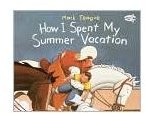'No Copycats Allowed': 2nd Grade Book Activity on Being Yourself
It is said that imitation is the sincerest form of flattery. It’s a common occurrence with children and adults, copying what others do, say or wear just to fit in with the crowd. While some of that behavior is acceptable, sacrificing who you really are, just to fit in, is not a good idea.
Or how about the child who makes up or exaggerates stories just to try to impress others? That might be a good trait for a creative writing assignment but in real life, it can get a person in trouble.
So when you see these types of behaviors in your classroom, it may be time for you to do a lesson with the theme “just be yourself”. Especially with young children, you want to encourage a strong sense of self so their self-confidence can carry them through difficult times.
No Copycats Allowed
To begin the lesson, read the book No Copycats Allowed by Bonnie Graves. This is the story of a girl named Gabrielle who is
entering second grade in a new school. She is understandably nervous as her older brother walks her to her classroom. His advice is, “…do what everyone else does.” As the day progresses, Gabrielle takes this to an extreme. She changes the spelling of her name to copy the spelling of each new friend she is trying to impress. She also changes her favorite interest to match the new friend. When her new friends call her a copycat, she is traumatized.
What’s in a name?
Names are important part of a person. You’ll notice that when you call a person by name their faces often “light up”. Gabrielle changes the spelling of her name several times. Now your students should examine their names and those of their classmates.
1. Who has the longest first name? The shortest?
2. Who has the longest last name? The shortest?
3. Who has the most vowels in their name?
4. Challenge the girls in the class to put themselves in ABC order by first name and then do it again by last name. Do the same with the boys. Then do this with the whole class. (You’ll be able to see right away the class leaders who take charge and put everyone in order.)
Homework:
Students must find who chose their name and why. Were they named after a relative or friend or for some other reason. The children will take pride in themselves and their names.
Compare the hair!
Gabrielle’s hair is described as, “black-as-pepper curls”. Instruct each student to draw a picture of themselves from the neck up, paying particular attention to the hair. Then they must write a description of their hair (or eyes, nose, mouth, etc.) comparing it to something else. Be proud that you are unique and special.
Tall Tales

Use the book How I Spent My Summer Vacation by Mark Teaque to demonstrate how a lively imagination can really change the truth. Point out the difference in what is real and what is exaggerated. In the story it is entertaining but in real life it isn’t.
Discuss how you feel when friends make up things that you know are not true. For example, if one child excitedly says, “I got a new bike for my birthday” and another child says, “Well, I have three bikes and one has a motor and I ride it in the street.” How does the first child feel? Bragging and telling half-truths are not ways to win friends. Being yourself is better and easier. If you tell too many tall tales, they are hard to remember and things get confusing.
Instruct your students to write two sentences/paragraphs about their summer vacations. One of them should be true and the other exaggerated. Read both aloud and have students guess which is true.
Encouraging a student to just be yourself is an ongoing process. Find time to give each student sincere praise for something each day. That goes a long way to building a child’s self-esteem. Then they will want to be themselves!
